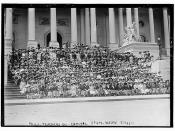The context of teaching has changed over the past two decades, and it is going to continue to change even more so in the coming century. Our democratic society is being transformed as we rapidly move toward an information society and a global economy. The changes are taking place more quickly than schools seem able to accommodate. From cognitive theorists to political leaders, individuals outside schools are pressuring educators to teach students how to frame and solve problems, to think critically, to develop a multicultural awareness, and to demonstrate mastery of basic skills. All of these demands have significant implications for teaching.
Conceptual FrameworkEducators have realized that for students to be successful in the twenty first century they are going to need to be lifelong learners. Helping them to achieve the skills that they will need to become successful lifelong learners requires a different approach to teaching and learning. The direct instruction method that was primarily used in the earlier part of the century, though still effective for teaching of some skills, is losing out to a more cooperative approach to learning.
The new approach involves students working collaboratively toward common goals, teachers being 'experts', coaches, and facilitators of learning and allowing students to discover answers for themselves (Conway, 1994).
Schools systems are feeling tremendous pressure to improve student achievement levels and the quality of the teaching staff. This pressure is not anything new; it has roots in three reports that were issued in the years between 1983 and 1996. In 1983, A Nation at Risk (National Commission on Excellence in Education) was published, which focused on the need for greater accountability of student learning. A second report, A Nation Prepared: Teachers for the 21st Century (Carnegie Corporation of New York) was published in 1986. This...



Nicely written paper
The paper is nicely written and has good information on the subject
1 out of 1 people found this comment useful.